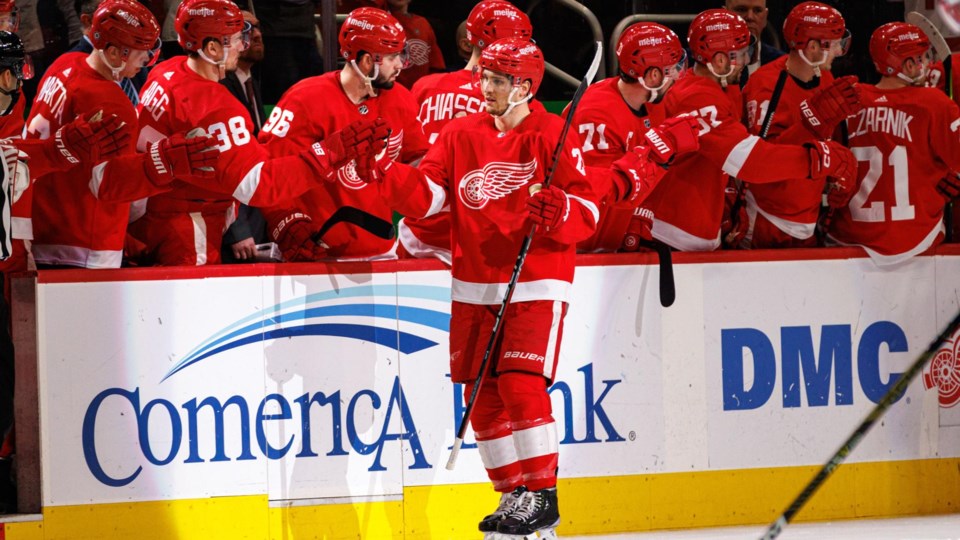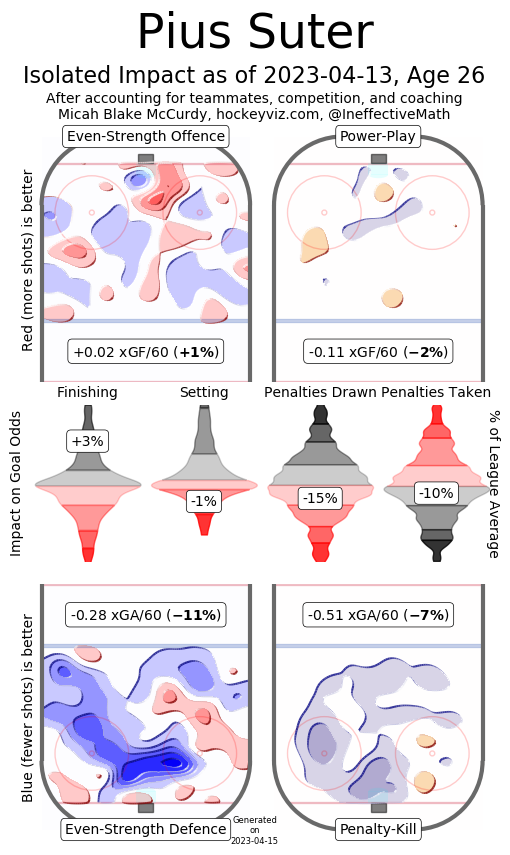August is typically a quiet month around the NHL. June has the end of the playoffs and the NHL draft. July has the start of free agency. September has the start of training camp and the preseason. But not much of anything happens in August.
Thatās why itās strange that what might be one of the Ā鶹“«Ć½Ó³»Canucksā most important signings took place in mid-August.
The Canucks signed free agent centre Pius Suter on Friday, inking him to a two-year contract with an average annual value of $1.6 million.
Thatās a significant paycut from the $3.25 million per year Suter made on his last contract and a steal of deal for a player that should be the foundation of the Canucksā third line. Suter should also significantly help the penalty kill and provides key centre depth in case of injury, because heās capable of playing up the lineup.
In other words, heās exactly the type of player the Canucks needed and he could make a significant difference in their quest to get back to the playoffs.
But if Suter is that good, why was he still available in August? In fact, why was he available at all? Why didnāt the Detroit Red Wings re-sign him?
Why Suter was signed in August
Suter reportedly was only getting one-year offers around the NHL but was looking for a little bit more security. The Canucks were the only team to offer him the second year he wanted.
One reason he wasnāt getting the offers he was looking for is that heās limited offensively. Heās not terrible, by any means, but a reasonable expectation is around 15 goals and 30 points. Heās got decent hands around the net, can do a little playmaking, and is capable of the occasional highlight-reel play, but he generally defaults to making safe passes in the offensive zone instead of showing more creativity.
Thatās not a problem if heās a third-line centre but the Red Wings often used Suter as a top-six winger and he fell short of producing like one.
The other potential reason is that he doesnāt exactly fit the mould of a defensively-responsible, checking-line centre. Heās on the smaller side of NHL forwards at 5ā11ā and 174 lbs and, while heāll take the body on the forecheck and competes ably in battles, the physical side of the game is not his strong suit.
Suter also isnāt particularly good on faceoffs, with a career 46.7% faceoff percentage. That might make some coaches hesitant to give Suter a plethora of defensive zone starts against elite competition.
So, Suter doesnāt produce enough offence to be a regular top-six forward and lacks the attributes of a typical checking-line centre ā why should the Canucks and their fans be excited?
Simple: while Suter lacks the look of a high-end defensive centre, he gets results like one.
Suterās excellent defensive metrics
Suterās defensive game shows strongly in pretty much every advanced analytic available to the public.
Among Red Wings forwards who played at least 40 games last season, Suter was on the ice for the lowest rate of unblocked shot attempts against and shots on goal against at 5-on-5 and the second-lowest rate of goals against at 5-on-5.
In the defensive component of Goals Above Replacement (GAR) statistic, Suter was worth 5.3 GAR last season. That ranks 11th among all NHL forwards in that defensive metric.
According to Isolated Impact heatmap, Suter had a significant influence defensively. When he was on the ice at 5-on-5, he made the opponentsā scoring chances 11% less dangerous than the league average, according to this metric.
As illustrated by the bottom right corner of Suterās Isolated Impact heatmap, that defensive game shows up on the penalty kill too, where he was a go-to forward for the Red Wings.
Among Red Wings forwards with at least 20 minutes on the penalty kill, Suter was on the ice for the lowest rate of unblocked shot attempts against, shots on goal against, expected goals against, and goals against.
Evolving Hockey rated Suter 2.3 GAR on the penalty kill, which ranked seventh among all NHL forwards.
Do Suterās analytics show the whole picture?
Suterās advanced analytics paint a picture of a player who isnāt just a good defensive forward but possibly one of the best in the NHL.
That comes with some caveats, however. A big one is that predicting how a player will perform in a different context is difficult. Some players change teams and donāt miss a beat or even get better with a new set of teammates; others struggle in a new environment. Fit matters and thereās no telling yet how Suter will fit into the Canucksā roster.
Another potential red flag is that this was easily Suterās best performance defensively in his three seasons in the NHL.
Both Evolving Hockey and HockeyViz rated Suter below average defensively at 5-on-5 in the 2021-22 season, his first with the Red Wings. He took a significant step this past season in his defensive game but is it an outlier? Will he fall back to earth with the Canucks or is last season a reflection of who he will continue to be in the future?
In addition, Suter spent a big chunk of last season on the wing ā what role did that play in his fantastic defensive metrics? If heās a full-time centre with the Canucks, will he be able to maintain that defensive game or did the reduced responsibilities on the wing help him?
āHeās a very valuable player because heās smart.ā
Even with those caveats in mind, there are a lot of reasons to be optimistic.
While he lacks some of the attributes one might expect from a third-line centre, primarily the size, he makes up for it with his brain.
Simply put, Suter is smart. He has excellent hockey sense and the mobility to make the most of his intelligence.
āHe's a very valuable player because he's smart," . "He can play in all different situations. He's centred our fourth line, been on our first line, kills penalties and plays the wing. The security of having him after our power play that next shift is very important.ā
Itās not just that he knows how to follow the details of a defensive system but that he has the awareness to break out of the system to make the better defensive play.
This moment against the Pittsburgh Penguins illustrates that awareness. Suter is on the left side, playing the wing for a defensive zone faceoff. His responsibility off the faceoff is the defenceman at the point and he makes a movement in that direction, but then recognizes the scrambled draw and sees that Jason Zucker has slipped his check to get to the net.
Suter reads the play and gets to Zuckerās stick to disrupt the scoring chance, then boxes out Zucker to prevent him from getting a shot on the rebound. Momentarily tied up by Anthony Angello, Suter shakes free and gets out to Evgeni Malkin to deflect his shot attempt out of play.
Itās a solid sequence of reading whatās happening on the ice and making the right play to prevent even a single shot on net, completely neutralizing a dangerous situation.
That awareness is constant for Suter, whose head is on a swivel at all times in the defensive zone. It shows up on the backcheck as well, as he doesnāt just bury his head to get back but scans the ice and picks up his check.
Itās also a big reason why heās effective on the penalty kill, as he makes good reads and puts himself in the right position to break up passing lanes. Hereās one example against the Boston Bruins, where he pushes aggressively to the point, but then smartly tracks back into the slot with the Bruinsā Pavel Zacha, then reads the backdoor play perfectly to pick off the pass and clear the zone.
The Canucks, quite frankly, need more forwards with that type of defensive awareness. The Canucksā defensive struggles last season canāt be solely on the teamās defencemen, as their forwards frequently fell asleep and failed to take away passing lanes or the open man. Adding Suter and his fellow defensive-minded centre Teddy Blueger should help significantly.
Even if Suter is not the same defensive whiz in Ā鶹“«Ć½Ó³»as he was this past season in Detroit, just adding one more proven, capable two-way centre does wonders for balancing the Canucksā lineup.
Suter and Blueger donāt just give the Canucks a slant rhyme but also the type of reliable centre depth they need behind Elias Pettersson and J.T. Miller. One of their main issues heading into the offseason was too many wingers and not enough centres ā they addressed that issue without breaking the bank.
Having a balanced lineup could be the difference between making and missing the playoffs, as it could allow head coach Rick Tocchet to roll all four lines and more easily manage his match-ups. Suterās signing is a small deal that could make a big difference.





